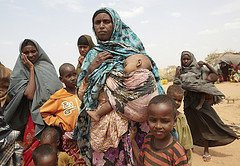Everyday brings grim new figures from the famine in Somalia. The latest is this: according to nutrition and mortality surveys by USAID 29,000 children under the age of 5 have died in the last 90 days in southern Somalia. And it’s going from bad to worse. On Wednesday, the UN announced that the famine has spread beyond the regions in Southern Somalia to three other areas—including parts of Mogadishu.
How did it get this bad? The Horn of Africa, which includes parts of Kenya and Ethiopia, Eritrea, Djibouti and Somalia, is experiencing its worst drought in 60 years. This caused crop failures, livestock deaths and massive displacement. But it is not causing a famine in in Djbouti, Ethiopia, or Eritrea. Rather, epic drought made the leap to famine only in the parts of Somalia that are controlled by the militant group al Shabaab. These regions have been no-go areas for humanitarian groups for several months. In the past, aid groups operating in the area have been targeted by al Shabaab.
The centrality of an al Qaeda affiliated terrorist group to this crisis has tempted pundits one into thinking that there is a military solution to this crisis. In an editorial earlier this week, the Washington Post dismissed the likelihood of a military response, but nonetheless surmised, “Probably only an international military intervention could prevent mass starvation.”
In fact, we do not need to invade and occupy Somalia in order to fight this famine. Drones won’t solve the problem either. Rather, what we need are two things: money to fund a robust humanitarian response in the near term and a long term diplomatic effort aimed at promoting stability in the Horn of Africa.
Money. Right now, there is over a $1 billion shortfall in aid to the region. According to the UN Office for the Coordination of Humanitarian Affairs, “Out of an estimated US$2.5 billion in humanitarian requirements for Djibouti, Ethiopia, Kenya and Somalia, $1.2 billion has been committed.” The United States is single largest donor–its given $458,264,453 so far this year. That is a significant sum, but the needs are immense.
One complicating factor to the humanitarian response so far is that al Shabaab is a State Department designated terrorist group. This means there are broad restrictions against American humanitarian funding in regions under al Shabaab’s control. NGOs have been very reluctant to operate in Somalia for fear that they may violate the domestic laws of the world’s largest humanitarian donor.
On top of that, al Shabaab has a history of targeting aid workers. In the past, it kicked several agencies out of areas under their control. In recent days, restrictions seem to be loosening. Over the past week, however, some NGOs have gained unfettered access into areas erstwhile under the control of al Shabaab leaving humanitarians cautiously optimistic that they may soon get wider access to famine affected areas.
To its credit the Obama administration modified the restrictions to allow greater American aid to reach al Shabaab controlled territory. The problem, however, is that the new directive applies only to US government funded operations; that is, NGOs which do not receive funds from the United States government are not covered by this waiver. “We have some remaining concerns about how the new arrangement will be implemented, particularly the fact that it only applies to programs that are wholly or partly funded by the US Government,” Mercy Corps Jeremy Konyndyk told congress on Wednesday. “This provides no protection to interventions implemented by US organization with funding from private foundations or European donors.”
This is one potential obstacle that can — and should — be lifted to allow for greater humanitarian access. As officials are quick to note, there are 11 million people affected by this crisis in the region. There are not 10 million al Shabaab militants. The humanitarian response needs to be ramped up. And fast.
Diplomacy. The defeat of al Shabaab is not something that can be solved militarily. If anything, our experience in Afghanistan should demonstrate just how difficult (if not impossible) it is to suppress a broad-based insurgency.
To a certain extent, al Shabaab is a creation of misplaced American priorities in the region that valued short-term counter-terrorism gains above all else. In 2006, the United States backed its ally Ethiopia in a military operation against a group known as the Islamic Courts Union. Even though the Islamic Courts Union brought a degree of stability that Somalia had not experienced in several years, the Bush administration feared that it would give terrorist groups a foothold in the region. The US-backed Ethiopian invasion crushed the Islamic Courts Union, but gave rise to the al Shabaab insurgency which now wages battle against the incompetent and corrupt Transitional Federal Government. In the meantime, governments neighboring governments are arming local militias and making Somalia ground zero for a series of regional proxy wars.
Does this sound like a problem that can be droned away? Not likely. Rather what is needed in the long term is a diplomatic process these regional considerations into account. Sarah Margon, a fellow at the Center for American Progress and former aid to Senator Russ Feingold argues that the president should appoint a high level special envoy for the Horn of Africa to help guide this diplomatic process. “Someone with direct access to the Secretary of state or even the president,” she says.
That would be a good start. For too long, American policy in the region has been driven by short-term counter-terrorism considerations. The humanitarian disaster that is afflicting the region gives the Obama administration the opportunity to reset its policy. Thousands of lives hang in the balance.
